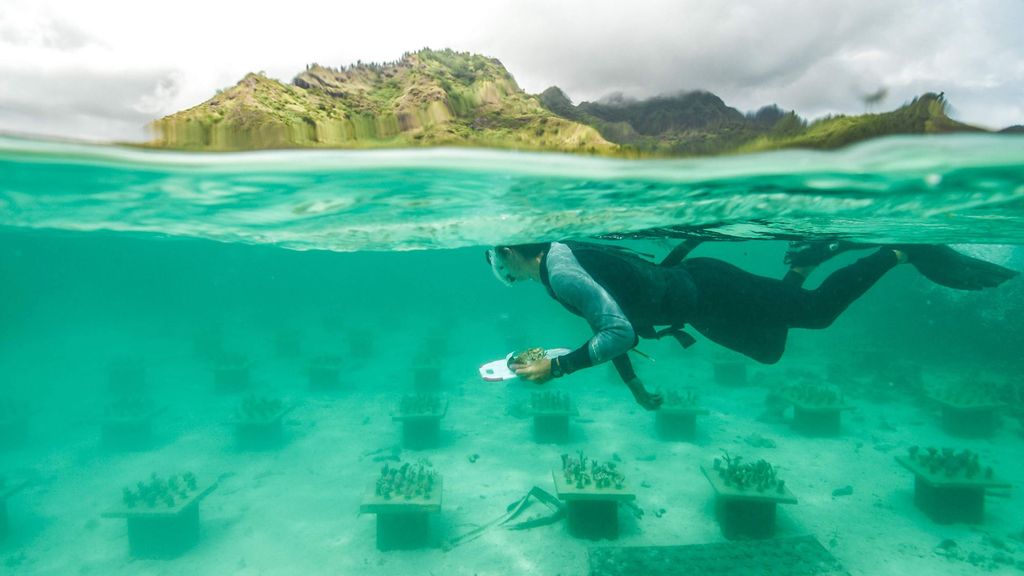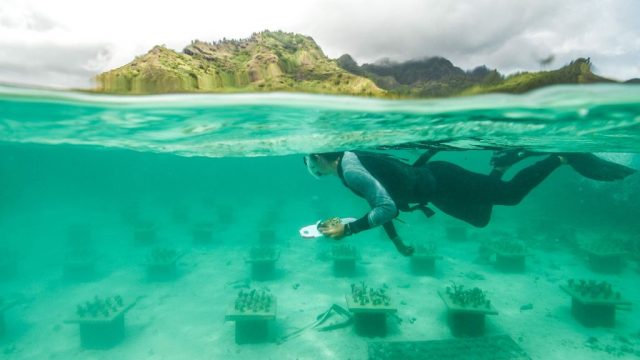
By Peter Barker
Stunning underwater gardens are part of a project by researchers at the Georgia Institute of Technology to save coral reefs from destruction by increasing their survivability and growth.
Corals face threats on multiple fronts, with overfishing and coral bleaching dealing especially heavy blows to reefs across the world.
In search of a solution, Cody Clements and Mark Hay at the Georgia Institute of Technology have found that planting a diverse group of coral species together improves coral growth. Their study, published in the journal Science Advances, noted that this strategy is especially important in the early stages of a reef’s recovery following large-scale coral loss.
“Corals are the foundation species of [marine] ecosystems, providing habitat and food for numerous other reef species. Negative effects on corals often have cascading impacts on other species that call coral reefs home. If biodiversity is important for coral performance and resilience, then a ‘biodiversity meltdown’ could exacerbate the decline of reef ecosystems that we’re observing worldwide,” said Clements.
Coral reefs occupy less than one percent of the world’s oceans, but approximately 25 percent of marine fish species inhabit them for some part of their lives, making them immeasurably important to the world’s ecosystems.
Around 50 percent of the world’s coral reefs died in the past 20 years, and over 90 percent are expected to perish by 2050, according to the United Nations Development Program.
Moreover, the Environmental Protection Agency has reported that the Caribbean has lost 80–90 percent of its coral cover.
During the bleaching event of 2015–2016, 93 percent of Australia’s Great Barrier Reef was affected by bleaching, with 316 reefs of 911 studied experiencing “extreme bleaching,” according to the Australian Research Council.
“The frequency of these big bleaching and heating events that are killing off corals has increased fairly dramatically over the last 20–30 years,” said Hay. “There are hotspots here and there where coral reefs are still good, but they’re small and isolated in general.”
Clements and Hay traveled to Mo’orea, French Polynesia, in the tropical Pacific Ocean, where they planted coral gardens, made up of diverse corals, on underwater tables. The researchers evaluated the survival rates of the corals as they grew and interacted with each other, as well as the importance of mutualism versus competitive interactions among them.

“We’ve done the manipulations, and the corals should be competing with each other, but in fact, they do better together than they do on their own,” said Hay.
“We are still investigating the mechanisms causing this surprising result, but our experiments consistently demonstrate that the positive interactions are overwhelming negative interactions in the reef settings where we conduct these experiments,” said Hay. “That means when you take species out of the system, you’re taking out some of those positive interactions, and if you take out critical ones, it may make a big difference.”
According to Hay, this study is unique from other similar ones as it was conducted in the real world and not in a lab.
“We do all of our experiments in the real world. We’re not as interested in whether it can happen, but whether it does happen,” he said.
The gardens were made on tables with Coca-Cola bottle caps embedded in them. The scientists then cut open the bottles at the neck and glued corals into the upturned bottle necks, which allowed them to screw the coral samples into any table they chose and mix species accordingly.
The corals could also be weighed every few months in this way, giving the researchers accurate data on growth rates.

The results showed that corals benefited from increased biodiversity “up to a point,” according to Clements.
“Corals planted in gardens with an intermediate number of species, three to six species in most cases, performed better than gardens with low, or one, species, or high, as in nine, species. However, we still do not fully understand the processes that contributed to these observations.
“We need a better mechanistic understanding of how diversity influences these processes to predict how biodiversity loss will impact corals, as well as how we may be able to harness biodiversity’s positive influence to protect corals,” said Clements.
Edited by Siân Speakman and Kristen Butler
The post VIDEO What A Re-Reef! Undersea Coral Gardens Could Save Threatened Colonies appeared first on Zenger News.




